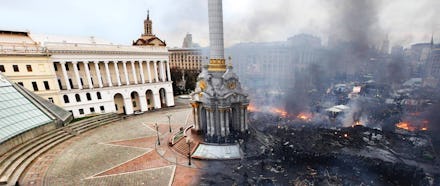2 Months After the Ukrainian Revolution, Here's What Independence Square Looks Like

I went on a stroll late last week through central Kyiv, across Independence Square, which for months was the seat of Ukraine's anti-government protests. On the far end of the square, a bulldozer was slowly dismantling the barricade that once separated hundreds of thousands of protesters from pro-government security forces.
Here lie the remnants of the revolution.
Independence Square was the emblem of the Euromaidan movement. ("Maidan" is a Ukrainian word for "square.") But almost five months after protests broke out — and two months since the toppling of Viktor Yanukovych's pro-Russia government — the fate of the Maidan remains uncertain. The square has largely been cleared, but not everyone is ready to go home.
Nowadays, the Maidan is quiet. People roam on foot, some stopping to photograph the many small memorials scattered around the area. Near the center of the square, the Trade Union building, once the Euromaidan's HQ, stands charred and blackened, its glass windows blown through. Nearby, walls are littered with graffiti and weathered posters, cartoon drawings of a deformed Vladimir Putin and banners declaring "Glory to Ukraine!"
But the Maidan is not clear yet. Parts of the old tent encampment remain, and hundreds of militia members are reportedly still living on site. Some of the men wear army fatigues. And some claim to hold weapons arsenals.
Heather McGill, a Ukraine specialist with Amnesty International, told the Wall Street Journal that Amnesty is concerned about “large numbers of militaristic-looking men with batons who don’t have an official license to perform that job."
With attention now shifted east, to the Russian-speaking strongholds of Kharkiv, Donetsk and Luhansk, it remains to be seen what will happen to the Maidan. Sviatoslav Yurash, a young activist who spent months on the square, wants the Maidan to be turned into a memorial: "To keep this powerful sacrifice in the memory of our nation, it is important to keep the symbols alive." Yurash has left Maidan but speaks nostalgically of his days there. He calls the square his "paradoxical home."
But Alena Stuliy, a film student in Kyiv, says the Maidan has not exhausted its purpose. "We still have problems in our country. The situation in eastern Ukraine is terrible," she says. And so Stuliy and her friends will continue to meet on the square.
After WWII, the Maidan was rebuilt by Soviet architects, its wide boulevards and central assembly points recast in Stalinist style. Until recently, a centerpiece of the square was a large granite statue of Vladimir Lenin, but protesters tore down the monument in December and replaced it with a European Union flag.